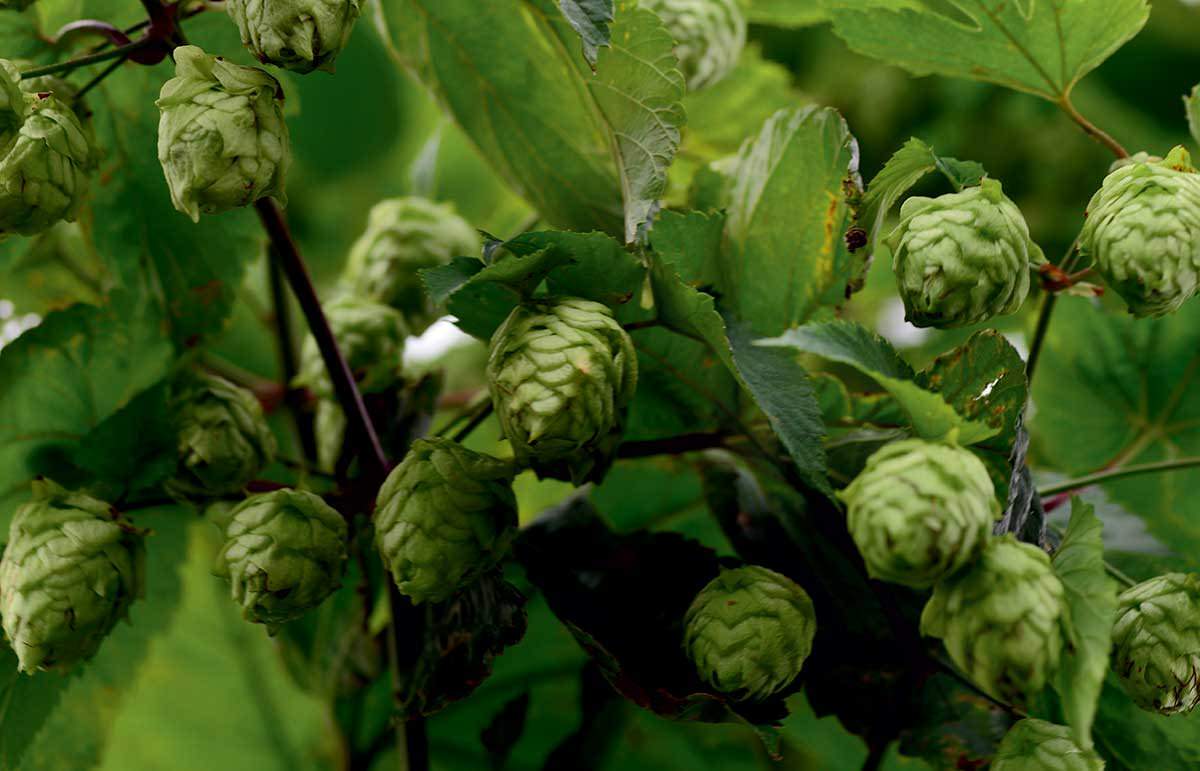Pale ales. Pilsners. Lagers. The artisanal beer business is booming, making this vigorous climbing plant a sure bet for savvy commercial growers.

You don’t need us to tell you that it’s tough to swing a proverbial cat without hitting a brew-pub these days. The American craft beer industry grew by 20 percent in 2013 alone. The surprise: Small-batch brewing requires four to five times more hops cones (the unopened female flowers behind an ale’s bitterness) per ounce than mass-market beer manufacturing. Good thing, then, that this vigorous “bine” (a vine that climbs via main stem rather than offshoots) comes by its Latin name, Humulus lupulus, or “little wolf,” honestly. You just need to give the hungry-like-a-you-know-what plants, hardy from Zones 3 to 9, proper structure.
[mf_h2 align=”left” transform=”uppercase”]Trellising[/mf_h2]
Home brewers looking to produce a few cones – and backyard gardeners seeking a fast-growing ornamental – might enlist a trellis or two. More serious, yet still small-scale, farmers should consider devoting the side of a barn, garage, or house to hops cultivation: Screw a series of eyehooks into the eaves and run twine through the hooks and back, securing it with stakes. Larger operations will want a more elaborate system. Using 120 telephone poles and a ton of wire cable per acre, install the poles so they form an evenly spaced grid. String the cable 12 to 20 feet overhead from pole to pole, through eyebolts inserted into the poles. Anchor the twine with stakes and run it up to the cable.
[mf_list_sidebar layout=”basic” bordertop=”yes” title=”15 Hops Varieties Beloved By Beer Makers”]
‘Brewer’s Gold’ Moderate-yield, late-season crop. Fruity, spicy, black currant flavors. Good for ales, pilsners, lambics, and saisons.
‘Cascade’ High-yield, mid-season crop. Flowery, citrusy flavor with grapefruit notes. Good for American ales, IPAs, porters, and Belgian whites.
‘Chinook’ High-yield, mid- to late-season crop. Medium aroma and piney flavor with an exotic spiciness. Popular with home brewers. Good for pale ales, lagers, porters, and stouts.
‘Galena’ Moderate yield, early- to midseason crop. Citrusy and slightly spicy flavor. Good for stouts, porters, brown ales, IPAs, pale ales, wheat beers, and other light ales.
‘Zeus’ High-yield, early- to mid-season crop. Earthy, spicy, pungent flavor with mild citrus tones. Good for American ales, pale ales, IPAs, and stouts.
[/mf_list_sidebar]
[mf_h2 align=”left” transform=”uppercase”]Growing[/mf_h2]
Plant hops rhizomes (root stems) in early spring, a few inches deep and about 42 inches apart, with the brown rootlets pointing down. Water with a drip-irrigation system or soaker hose to reach the roots instead of merely wetting the leaves. Once the shoots are a foot tall, cut all but two of them per plant (sauté the rest into a dish of “poor man’s asparagus”) and wrap the remaining ones clockwise around the trellis or twine.
[mf_h2 align=”left” transform=”uppercase”]Harvesting[/mf_h2]
Hops should be harvested when the cones are fragrant and green – between mid-August and mid-September, depending on location and variety planted. If the hops are growing against a building, you can simply cut the twine and pull the entire trellis down. Harvesting a bigger area can be done by hand, using a ladder, or with a machine designed for the purpose. (Large harvesters can run $180,000, though Wisconsin’s Gorst Valley Hops sells a small version geared to farms of less than 50 acres for $13,000.) Hops are best fresh, but dried cones (sealed in a paper or plastic bag and set in a warm attic) should remain viable for a few years.
[mf_h2 align=”left” transform=”uppercase”]The Bottom Line for Hops[/mf_h2]
Establishing an acre of rhizomes with trellising and drip irrigation will run you $6,000 to $10,000. Bigger operations – 10 acres or more – require an investment in specialized equipment for harvesting, hauling, and drying.
- Number of plants per acre: 750 (average)
- Price per rhizome: $.20 to $2, depending on volume and variety
- Harvest per acre: between 1,200 and 2,500 pounds fresh (wet) hops
- Price per pound of fresh hops: $4 to $20, depending on variety and quality of cones
- Gross revenue per acre: $8,000 to $12,000, after crop is fully mature, in five years
- Life span of plants and trellising: 20 years (with minor upkeep along the way)
You’ll find a good selection of varieties at thymegarden.com, northwesthops.blogspot.com, or highhops.net. Trellising supplies are available at usahops.org. Helpful books include The Hop Grower’s Handbook, by Laura Ten Eyck and Dietrich Gehring (Chelsea Green), and The Homebrewer’s Garden, by Joe and Dennis Fisher (Storey).
Looking for new crops to grow in South Africa
Grew some hops from rhizomes, got a pretty decent harvest in around 6 months! Got Japanese Lager fermenting using them right now! Thank you for sharing with us.